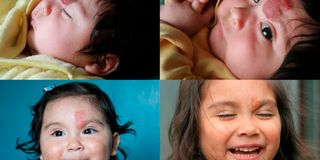When the brain is in your face, literally

Encephaloceles can occur in the face like or in the back of the head, at the occiput.
What you need to know:
- Encephaloceles can occur in the face or in the back of the head, at the occiput.
- The back ones are more common. They are also more common in boys, except in Thailand where the face ones are more common and in girls.
The Ben Carson magic may be slowly fading but this man has single-handedly inspired millions of children across the globe to want to be neurosurgeons. Not doctors, neurosurgeons!
Forget the journey, today it is about content. Ben Carson’s story strongly emphasised the gruelling process of attaining the skills and the qualifications. He did not sugar-coat it. The endless call hours, the snippy professors who made one feel they were not good enough to earn the prestigious title, the voluminous reading, the long surgeries and the incessant worries of whether your patient will end up better or worse after tinkering with their brain.
Ben Carson never prepared me for my final surgical rotation examination in the short cases section! First of all, I misread the exam time table. I assumed the clinical exam would start at 8 o’clock in the morning like all others. Apparently, due to the multiple surgical specialty areas for examination, it was scheduled for 7 o’clock instead.
I strolled in at 7.30am exuding false confidence. One would have to be crazy to have real confidence in this particular examination! It took me a minute to understand why my colleagues looked at me weirdly. I panicked! Not a good thing to do on the last day of medical school examinations. One is already high strung and exhausted mentally and physically from the preceding two weeks of madness.
Prof Tenge Kuremu, the venerable paediatric surgeon, was responsible for allocating us patients for the examination. He saw my panic and graciously extended his hand. He gave me a firm handshake and instead of chiding me, he reassured me that I was ready for the exam. It is no wonder he works with children, he has a pure soul!
He proceeded to escort me to the patient’s bedside, and to my relief, I got a paediatric patient. Children always make for amazing patients in the examination. I knew I was acing this part of the exam and I could feel my confidence collecting itself off the floor.
With the first part of the exam done, I proceeded to the next section. These were the short cases. One had 10 minutes with the patient and the examiners, to diagnose a condition and discuss it. The diagnosis was intended to be straight forward due to the limited time allocated. The first one went well, further boosting my confidence.
Nothing prepared me for the second part! The little one sitting on the bed next his mum was happily munching on banana. He was lively, with inquisitive eyes peering out from behind this soft lump that sat splat right between the two eye sockets! The lump appeared to grow right out of the inner end of the left eye. It looked like an eggplant hanging on its stalk, resting on his nose.
Right there and then, I knew I wasn’t ready to be a surgeon! When the examining doctor asked me to touch it and describe the mass, I froze. I couldn’t bring my feet to move any closer to the baby. My brain was screaming at me to get the examination done but my hands refused to obey. I was convinced that touching the soft mass would cause the baby pain and I had no intention of making him cry.
The rest of my mind could not think and I was unable to diagnose what was right in front of me. Doctors who teach must be born with a special talent in patience! The examiners asked me to take a breath and start again. From the corner of my eye, I could see the baby’s mum trying unsuccessfully to hide her mirth! Her eyes were dancing with laughter.
That was my first encounter with a spheno-ethmoidal encephalocele. This is a congenital abnormality in the baby where part of the brain, together with its protective membranes, the meninges, and cerebrospinal fluid, herniate through a gap in the skull wall. In this case, the gap was in the bones of the face right next to the eye.
Encephaloceles can occur in the face like for our baby’s case, or may occur in the back of the head, at the occiput. The back ones are more common. They are also more common in boys, except in Thailand where the face ones are more common and in girls.
There is no known cause for development of encephaloceles though genetic abnormalities have been identified in some cases. Nevertheless, folic acid deficiency remains the leading risk factor for abnormalities of the brain and spinal cord, encephaloceles included. Women bearing babies at the extremes of age (the under 18s and the over 40s), women on certain medications for epilepsy, obese women, diabetic moms, alcoholism, tobacco use and excessive caffeine consumption are some of the identified risk factors.
These risk factors can be easily reduced by an all-rounded healthy pregnancy lifestyle and folic acid supplementation. Antenatal screening and early diagnosis during pregnancy helps to prepare the parents for the birth of the baby and have an adequate plan of care for the unborn baby.
Treatment includes surgery and long-term follow-up to ensure achievement of developmental milestones. The outcome depends on the severity of brain involvement because what is outside of the skull is removed. The children may fully recover after treatment, with no residual complications. Others may suffer partial functional abnormalities, lifelong convulsions and milestone delays. Some may not survive the condition; with an almost 30 per cent mortality. Overall care involves family counselling and empowerment and a multidisciplinary team involvement.
I may have totally failed that part of the exam but I was grateful to my little exam patient for teaching me plenty!
Dr Bosire is an obstetrician/gynaecologist





